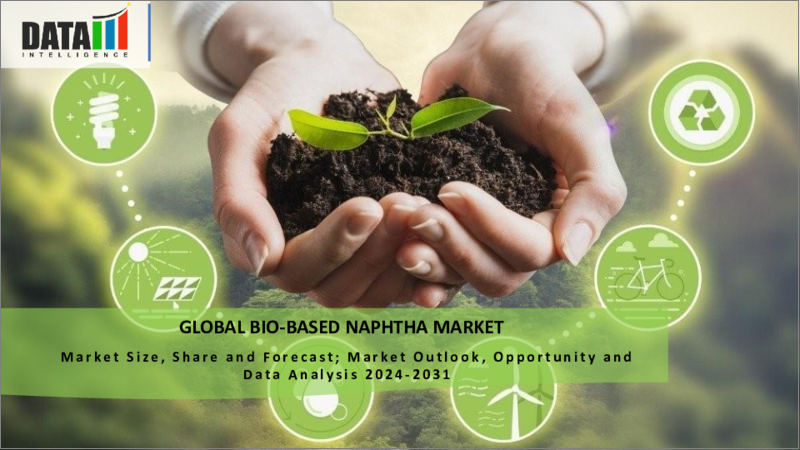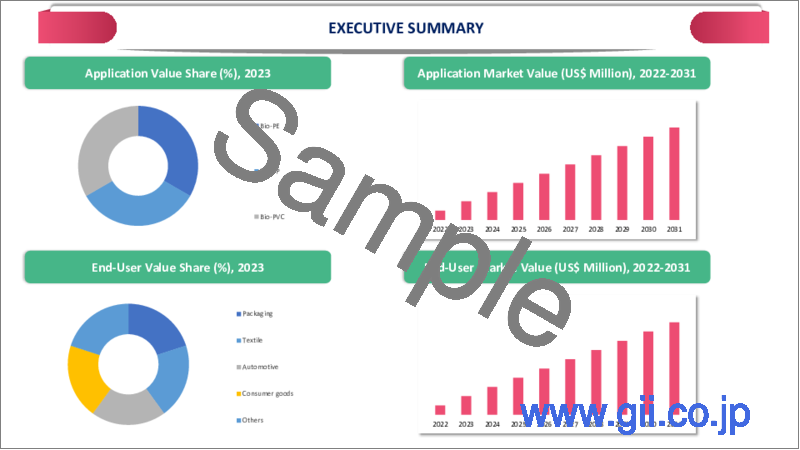|
|
市場調査レポート
商品コード
1372587
バイオベースナフサの世界市場-2023年~2030年Global Bio-Based Naphtha Market - 2023-2030 |
||||||
カスタマイズ可能
適宜更新あり
|
|||||||
| バイオベースナフサの世界市場-2023年~2030年 |
|
出版日: 2023年10月18日
発行: DataM Intelligence
ページ情報: 英文 186 Pages
納期: 即日から翌営業日
|
- 全表示
- 概要
- 目次
概要
バイオベースナフサの世界市場は、2022年に8億9,520万米ドルに達し、2023年から2030年にかけてCAGR 18.3%で成長し、2030年には33億3,870万米ドルに達すると予測されています。
バイオベースナフサ市場は、現在の世界における持続可能な燃料技術に対する需要の高まりとともに著しく成長しています。バイオ燃料は、短期的には小型車、長期的には大型トラック、船舶、航空機など、現在進行中の輸送技術のための低炭素ソリューションであるため、輸送部門の脱炭素化に大きな役割を果たしています。また、バイオベース燃料部門は、炭素排出を削減するための他の代替的で費用対効果の高いソリューションも提供しています。
さらに、IEAの報告書によると、2022年の世界のバイオ燃料需要は、170,000百万リットルに相当する4.3エクサジュール(EJ)で過去最高に達しました。この需要レベルは、2019年に観測されたCOVID-19大流行前のレベルを上回る。2050年までにネット・ゼロ・エミッション(NZE)という目標を達成するためには、バイオ燃料生産を大幅に増やす必要があります。NZEシナリオでは、バイオ燃料生産は2030年までに10EJ以上に達すると予測されており、これはバイオナフサなどのバイオ燃料に対する世界の需要の必要性を示しています。
欧州のバイオベースナフサ市場は、バイオベースナフサ市場で最も急成長する地域と予想されます。欧州は、2050年までにネット・ゼロ・エミッションを達成するという目標に向かって前進しています。欧州は、10年足らずの間にバイオベース経済の売上高を40%以上増加させるという目覚ましい成功を収めています。環境の持続可能性への大きな後押しが、さまざまな産業で再生可能製品やバイオベース製品の採用を加速させています。
力学
持続可能なバイオ燃料へのニーズ
バイオベースナフサ市場は、持続可能な燃料技術に対する需要の高まりとともに著しく成長しており、2022年には、主に道路輸送セクターにおいて、世界の輸送エネルギー需要の3.5%以上をバイオ燃料が占めるようになります。IEAによれば、この成長は一貫しており、2020年にCOVID-19の大流行により一時的に減少した以外は、バイオ燃料消費量は過去5年間ほぼ年率6%で拡大しています。ネット・ゼロ・エミッション・シナリオでは、2030年までにバイオ燃料が運輸部門に占める割合が2倍以上に増加し、特に道路用車両を中心に燃料需要全体の9%に達するという予測で具体的な目標を設定しています。
さらに、世界80カ国以上が、バイオ燃料の使用と需要を支援する政策を打ち出しています。こうした政策は、世界規模でバイオ燃料の普及を促進する上で重要な役割を果たしています。バイオ燃料は、世界の道路輸送用石油消費量の削減に重要な役割を果たし、2022年には世界の道路輸送用石油使用量の4%を削減することになります。これは、エネルギーベースで約200万バレルの石油の節約に相当します。
世界の輸送用バイオ燃料の拡大
バイオベースナフサ市場は、世界の輸送用バイオ燃料セクターの堅調な拡大により、再生可能ディーゼル生産に大きな焦点を当てた成長軌道にあると予想されます。IEAによると、2022年の輸送用バイオ燃料の生産能力は7%増と、過去10年間で最も大幅な伸びを記録しました。この拡大は、バイオ燃料と、バイオベースナフサを含む不可欠な原料に対する需要の高まりを示すものです。特に米国や欧州などの主要なバイオリファイナリーがこの成長の最前線にあり、バイオベースナフサに依存する再生可能ディーゼル生産を奨励する有利な政策や優遇措置の恩恵を受けています。
さらに、バイオ燃料部門には多額の投資が殺到しており、2022年には過去10年間では見られなかったレベルで、合計約26万キロバイト/日の生産能力が追加される予定です。カリフォルニア州でのマラソンとネステの合弁事業や、カナダでのインペリアルの多額の投資など、知名度の高い事業に代表されるように、投資は再生可能ディーゼル精製に顕著に向けられています。また、持続可能な航空燃料への関心の高まりがこの成長を後押ししており、ネステのような企業はこの需要に応えるために再生可能燃料工場を拡大しています。SAFは、航空セクターの排出量削減に不可欠であり、ナフサのようなバイオベース原料に依存しています。
バイオ燃料コスト高騰の影響
バイオベース燃料、特にバイオディーゼルのコスト高が、バイオベースナフサ市場に影響を与えています。NGO Transport &Environmentのレポートによると、現在の原料で生産されるバイオディーゼルは、卸売市場では化石ディーゼルの70%から130%高いです。この価格差は、バイオ燃料製造に不可欠な穀物、植物油、使用済み食用油、動物性油脂などの原料価格が高騰しているためです。
さらに、T&Eの調査によると、欧州におけるバイオ燃料の混合プロセスは、EUの燃料費に年間170億ユーロを上乗せしています。この経済的負担は、消費者に影響を与えるだけでなく、バイオベースナフサ市場にも影響を与えます。バイオ燃料の高コストが、バイオベースナフサの投資や採用を抑制し、その成長の可能性を妨げる可能性があります。
目次
第1章 調査手法と調査範囲
第2章 定義と概要
第3章 エグゼクティブサマリー
第4章 市場力学
- 影響要因
- 促進要因
- 持続可能なバイオ燃料へのニーズ
- 輸送用バイオ燃料の世界的拡大
- 抑制要因
- 高いバイオ燃料コストの影響
- 機会
- 影響分析
- 促進要因
第5章 産業分析
- ポーターのファイブフォース分析
- サプライチェーン分析
- 価格分析
- 規制分析
- ロシア・ウクライナ戦争分析
- DMI意見
第6章 COVID-19分析
第7章 供給源別
- 植物油
- バイオマス
- その他
第8章 用途別
- ガソリン
- 石油化学
- 航空燃料
- バイオベンゼン
- バイオフェノール
- その他
第9章 地域別
- 北米
- 米国
- カナダ
- メキシコ
- 欧州
- ドイツ
- 英国
- フランス
- イタリア
- ロシア
- その他の欧州
- 南米
- ブラジル
- アルゼンチン
- その他の南米
- アジア太平洋
- 中国
- インド
- 日本
- オーストラリア
- その他のアジア太平洋
- 中東・アフリカ
第10章 競合情勢
- 競合シナリオ
- 市況/シェア分析
- M&A分析
第11章 企業プロファイル
- Neste Corporation
- UPM Biofuels
- INEOS
- Gevo
- Euglena co., Ltd.
- AltAir Fuels
- Preem
- Shell Plc
- Eni S.p.A
- Diamond Green
第12章 付録
Overview
Global Bio-Based Naphtha Market reached US$ 895.2 million in 2022 and is expected to reach US$ 3,338.7 million by 2030, growing with a CAGR of 18.3% during the forecast period 2023-2030.
The bio-based naphtha market is significantly growing with the higher demand for sustainable fuel technology in the present world. Biofuels are playing a major part in decarbonizing the transport sector as they are the low-carbon solution for ongoing transportation technologies such as light-duty vehicles in the short term and heavy-duty trucks, ships and aircraft in the long term. The bio-based fuel c sector also provides other alternative and cost-effective solutions for reducing carbon emissions.
Furthermore, as per the IEA report, in 2022, global biofuel demand reached a record high of 4.3 exajoules (EJ), equivalent to 170,000 million liters. It level of demand surpassed the pre-COVID-19 pandemic levels observed in 2019. To achieve the goal of Net Zero Emissions by 2050 (NZE), there is a need for a significant increase in biofuel production. In the NZE Scenario, biofuel production is projected to reach over 10 EJ by 2030, which shows the required demand for biofuel globally such as bio naphtha.
The European bio-based naphtha market is expected to be the fastest growing region in the bio-based naphtha market. Europe is forwarding towards the goals to achieve net-zero emissions by 2050. Europe has achieved remarkable success in increasing the turnover of its bio-based economy by more than 40% in less than a decade. The major push to environmental sustainability has accelerated the adoption of renewable and bio-based products across various industries.
Dynamics
Need for Sustainable Biofuels
The bio-based naphtha market is significantly growing with the higher demand for sustainable fuel technology, with biofuels accounting for over 3.5% of global transport energy demand in 2022, primarily in the road transport sector. As per IEA, this growth has been consistent, with biofuel consumption expanding at an annual rate of nearly 6% over the past five years, except for a temporary decline in 2020 due to the COVID-19 pandemic. The Net Zero Emissions Scenario sets specific targets with the projection that biofuels will grow more than double their contribution to the transport sector by 2030 and will reach 9% of total fuel demand, especially for road vehicles.
Furthermore, more than 80 countries globally made policies that are supporting the use and demand for biofuels. The policies is playing crucial role in driving the adoption of biofuels on a global scale. Biofuels played a crucial role in reducing global road transport oil consumption, accounting for the avoidance of 4% of global road transport oil use in 2022. It translates to approximately 2 million barrels of oil saved on an energy basis.
Global Transport Biofuel Expansion
The bio-based naphtha market is on a growth trajectory expected to be driven by the robust expansion of the global transport biofuel sector, with a significant focus on renewable diesel production. As per IEA, in 2022, transport biofuel capacity experienced a remarkable 7% increase, marking the most substantial annual growth in over a decade. The expansion is indicative of the rising demand for biofuels and their essential feedstocks, including bio-based naphtha. Major biorefineries, particularly in regions like United States and Europe, are at the forefront of this growth, benefiting from favorable policies and incentives that encourage renewable diesel production, a process reliant on bio-based naphtha.
Furthermore, significant investments have flooded into the biofuels sector, with 2022 witnessing capacity additions at levels not seen in ten years, totaling approximately 260 kb/d. The investments are prominently directed towards renewable diesel refining, as exemplified by high-profile ventures such as the Marathon-Neste joint venture in California and Imperial's substantial investment in Canada. Also, the burgeoning interest in sustainable aviation fuels is propelling this growth, with companies like Neste expanding their renewable fuels plants to cater to this demand. SAFs, crucial for reducing emissions in the aviation sector, rely on bio-based feedstocks like naphtha.
Impact of High Biofuel Cost
The high cost of bio-based fuels, particularly biodiesel, is impacting the bio-based naphtha market. According to NGO Transport & Environment report, the biodiesel that is produced with the current feedstock is now between 70% and 130% more expensive than fossil diesel on the wholesale market. The price difference is because of the rising prices of feedstocks like cereals, vegetable oils, used cooking oil and animal fats, which are essential components in biofuel production.
Furthermore, T&E's study indicates that the process used with the blending of biofuels in Europe is contributing to the add-on €17 billion annually to the EU's fuel bill. It financial burden not only affects consumers but also has implications for the bio-based naphtha market. The high cost of biofuels may deter investment and adoption of bio-based naphtha, hindering its growth potential.
Segment Analysis
The global bio-based naphtha market is segmented based on source, application and region.
Vegetable Oil Dominates the Bio-Based Naphtha Market
Vegetable oil is expected to hold the largest segment in the bio-based naphtha market. Renewable naphtha produced from sustainable feedstocks, like from vegetable oil shows a significantly lower greenhouse gas footprint as compared to petroleum based naphtha. Also, depending on the feedstock used, this reduction can be as high as 50-80%. Moreover, the production capacity of renewable diesel and sustainable aviation fuel is increasing. The processes often yield coproducts through the hydrotreated vegetable oil (HVO) process, including bionaphtha and biopropane.
Furthermore, Honeywell has introduced a solution for producing renewable naphtha for petrochemical production using its Ecofining technology. It technology has been proven commercially and initially developed in collaboration with Eni SpA to convert non-edible vegetable oils and animal fats into renewable fuels, such as Honeywell Green Diesel and Honeywell Green Jet fuel. Honeywell aims to help petrochemical producers reduce the carbon footprint of their products by offering renewable naphtha as an alternative to petroleum-based feeds.
Geographical Penetration
Rapid Growth of the European Bio-Based Naphtha Market
The European bio-based naphtha market is experiencing rapid growth, driven by various factors that are reshaping the energy and petrochemical landscape. Bionaphtha, a versatile product derived from renewable sources, is at the forefront of this transition towards a cleaner energy future in the region. Supply and demand for bionaphtha are on the rise in Europe with innovative technologies and emerging regulations.
European companies like Neste and UPM are actively involved in the production and utilization of naphtha and they have witnessed substantial growth in the renewable products segment. Also, major players such as TotalEnergies, Shell and ENI are expanding their offerings in the renewable fuels and petrochemicals sector, further boosting the growth of bionaphtha. As per "Chem Analyst" article, current production levels of Bionaphtha in Europe range from 150,000 to 250,000 tonnes annually, with expansion projects on the horizon. Over the next four to five years, production is anticipated to double, reaching 500,000 tonnes, reflecting the region's increasing appetite for sustainable feedstocks.
Competitive Landscape
The major global players in the market include: Neste Corporation, UPM Biofuels, INEOS, Gevo, Euglena co Ltd., AltAir Fuels, Preem, Shell Plc, Eni S.p.A and Diamond Green.
COVID-19 Impact Analysis:
COVID-19 made a significant impact on the bio-based naphtha market, in the wake of the pandemic, many economies faced unprecedented challenges, including GCC (Gulf Cooperation Council) countries. The challenges led to a renewed focus on sustainability and environmental concerns within the chemical and petrochemical sectors. One positive outcome of this sustainability push in the GCC region is the increasing production and use of bio-naphtha, a renewable feedstock derived from sources like organic waste and biomass.
Despite the economic challenges posed by the pandemic, regional chemical producers in GCC countries, such as Saudi Arabia's SABIC and Kuwait's EQUATE, began expanding their portfolios to include circular and bio-based polymers. It strategic shift towards more sustainable practices reflects a global trend towards environmental consciousness and sustainability, as exemplified by the End Plastic Pollution resolution endorsed by 175 nations in Nairobi, Kenya.
Russia-Ukraine War Impact
The Ukraine-Russia conflict has had significant repercussions on various markets, including the bio-based naphtha market. The International Energy Agency (IEA) has indicated that reducing biofuel mandates in response to Ukraine-Russia conflict could result in increased petroleum demand and supply concerns. It shows the major dependency between food and energy systems and the potential consequences of policy changes in response to geopolitical events. The potential solution for this is to transition from 1st Generation biofuels to higher generations, such as 2nd or 3rd Generation biofuels.
By Source
- Vegetable Oil
- Biomass
- Other
By Application
- Gasoline
- Petrochemical
- Aviation Fuel
- Bio Benzene
- Bio Phenol
- Other
By Region
- North America
- U.S.
- Canada
- Mexico
- Europe
- Germany
- UK
- France
- Italy
- Russia
- Rest of Europe
- South America
- Brazil
- Argentina
- Rest of South America
- Asia-Pacific
- China
- India
- Japan
- Australia
- Rest of Asia-Pacific
- Middle East and Africa
Key Developments
- In September 2023, Alpha and Omega Semiconductor (AOS) has unveiled its MRigidCSP packaging technology, aimed at enhancing battery management applications. It technology is designed to reduce on-resistance while simultaneously increasing mechanical strength. Initially, AOS is offering MRigidCSP technology on its AOCR33105E, a 12V common-drain dual N-channel MOSFET. It packaging technology is well-suited for battery applications in devices like smartphones, tablets and ultra-thin notebooks.
- In November 2022, Cortec has introduced a sustainable solution in the form of EcoSonic ESD-safe bags, addressing challenges in electronic product packaging. The bags provide ESD protection to prevent damage from static charges and incorporate bubble wrap for impact protection. What sets them apart is the integration of Nano VpCl lining, which releases corrosion-resistant compounds into the bag's internal atmosphere, forming a protective molecular-scale layer around the product. It protects against moisture and corrosion without affecting solderability.
- In May 2023, Semtech has introduced its latest Transient Voltage Suppressors (TVS) product, the RClamp0822B, designed to offer high-performance electrostatic discharge (ESD) and surge protection. It versatile circuit protection platform aims to safeguard high-speed data interfaces across various circuit interfaces in industrial, data center and telecommunication applications. The RClamp0822B, with its very-low sub 1 picofarad loading capacitance, is ideal for protecting high-speed data lines from electrical transient threats. It also provides robust surge immunity and is packaged in a user-friendly SC-75 package, making it suitable for a wide range of industrial designs
Why Purchase the Report?
- To visualize the global bio-based naphtha market segmentation based on source, application and region, as well as understand key commercial assets and players.
- Identify commercial opportunities by analyzing trends and co-development.
- Excel data sheet with numerous data points of bio-based naphtha market-level with all segments.
- PDF report consists of a comprehensive analysis after exhaustive qualitative interviews and an in-depth study.
- Product mapping available as excel consisting of key products of all the major players.
The global bio-based naphtha market report would provide approximately 52 tables, 50 figures and 186 Pages.
Target Audience 2023
- Manufacturers/ Buyers
- Industry Investors/Investment Bankers
- Research Professionals
- Emerging Companies
Table of Contents
1. Methodology and Scope
- 1.1. Research Methodology
- 1.2. Research Objective and Scope of the Report
2. Definition and Overview
3. Executive Summary
- 3.1. Snippet By Source
- 3.2. Snippet By Application
- 3.3. Snippet by Region
4. Dynamics
- 4.1. Impacting Factors
- 4.1.1. Drivers
- 4.1.1.1. Need for Sustainable Biofuels
- 4.1.1.2. Global Transport Biofuel Expansion
- 4.1.2. Restraints
- 4.1.2.1. Impact of High Biofuel Cost
- 4.1.3. Opportunity
- 4.1.4. Impact Analysis
- 4.1.1. Drivers
5. Industry Analysis
- 5.1. Porter's Five Force Analysis
- 5.2. Supply Chain Analysis
- 5.3. Pricing Analysis
- 5.4. Regulatory Analysis
- 5.5. Russia - Ukraine War Analysis
- 5.6. DMI Opinion
6. COVID-19 Analysis
- 6.1. Analysis of COVID-19
- 6.1.1. Scenario Before COVID
- 6.1.2. Scenario During COVID
- 6.1.3. Scenario Post COVID
- 6.2. Pricing Dynamics Amid COVID-19
- 6.3. Demand-Supply Spectrum
- 6.4. Government Initiatives Related to the Market During Pandemic
- 6.5. Manufacturers Strategic Initiatives
- 6.6. Conclusion
7. By Source
- 7.1. Introduction
- 7.1.1. Market Size Analysis and Y-o-Y Growth Analysis (%), By Source
- 7.1.2. Market Attractiveness Index, By Source
- 7.2. Vegetable Oil*
- 7.2.1. Introduction
- 7.2.2. Market Size Analysis and Y-o-Y Growth Analysis (%)
- 7.3. Biomass
- 7.4. Other
8. By Application
- 8.1. Introduction
- 8.1.1. Market Size Analysis and Y-o-Y Growth Analysis (%), By Application
- 8.1.2. Market Attractiveness Index, By Application
- 8.2. Gasoline*
- 8.2.1. Introduction
- 8.2.2. Market Size Analysis and Y-o-Y Growth Analysis (%)
- 8.3. Petrochemical
- 8.4. Aviation Fuel
- 8.5. Bio Benzene
- 8.6. Bio Phenol
- 8.7. Other
9. By Region
- 9.1. Introduction
- 9.1.1. Market Size Analysis and Y-o-Y Growth Analysis (%), By Region
- 9.1.2. Market Attractiveness Index, By Region
- 9.2. North America
- 9.2.1. Introduction
- 9.2.2. Key Region-Specific Dynamics
- 9.2.3. Market Size Analysis and Y-o-Y Growth Analysis (%), By Source
- 9.2.4. Market Size Analysis and Y-o-Y Growth Analysis (%), By Application
- 9.2.5. Market Size Analysis and Y-o-Y Growth Analysis (%), By Country
- 9.2.5.1. U.S.
- 9.2.5.2. Canada
- 9.2.5.3. Mexico
- 9.3. Europe
- 9.3.1. Introduction
- 9.3.2. Key Region-Specific Dynamics
- 9.3.3. Market Size Analysis and Y-o-Y Growth Analysis (%), By Source
- 9.3.4. Market Size Analysis and Y-o-Y Growth Analysis (%), By Application
- 9.3.5. Market Size Analysis and Y-o-Y Growth Analysis (%), By Country
- 9.3.5.1. Germany
- 9.3.5.2. UK
- 9.3.5.3. France
- 9.3.5.4. Italy
- 9.3.5.5. Russia
- 9.3.5.6. Rest of Europe
- 9.4. South America
- 9.4.1. Introduction
- 9.4.2. Key Region-Specific Dynamics
- 9.4.3. Market Size Analysis and Y-o-Y Growth Analysis (%), By Source
- 9.4.4. Market Size Analysis and Y-o-Y Growth Analysis (%), By Application
- 9.4.5. Market Size Analysis and Y-o-Y Growth Analysis (%), By Country
- 9.4.5.1. Brazil
- 9.4.5.2. Argentina
- 9.4.5.3. Rest of South America
- 9.5. Asia-Pacific
- 9.5.1. Introduction
- 9.5.2. Key Region-Specific Dynamics
- 9.5.3. Market Size Analysis and Y-o-Y Growth Analysis (%), By Source
- 9.5.4. Market Size Analysis and Y-o-Y Growth Analysis (%), By Application
- 9.5.5. Market Size Analysis and Y-o-Y Growth Analysis (%), By Country
- 9.5.5.1. China
- 9.5.5.2. India
- 9.5.5.3. Japan
- 9.5.5.4. Australia
- 9.5.5.5. Rest of Asia-Pacific
- 9.6. Middle East and Africa
- 9.6.1. Introduction
- 9.6.2. Key Region-Specific Dynamics
- 9.6.3. Market Size Analysis and Y-o-Y Growth Analysis (%), By Source
- 9.6.4. Market Size Analysis and Y-o-Y Growth Analysis (%), By Application
10. Competitive Landscape
- 10.1. Competitive Scenario
- 10.2. Market Positioning/Share Analysis
- 10.3. Mergers and Acquisitions Analysis
11. Company Profiles
- 11.1. Neste Corporation*
- 11.1.1. Company Overview
- 11.1.2. Product Portfolio and Description
- 11.1.3. Financial Overview
- 11.1.4. Key Developments
- 11.2. UPM Biofuels
- 11.3. INEOS
- 11.4. Gevo
- 11.5. Euglena co., Ltd.
- 11.6. AltAir Fuels
- 11.7. Preem
- 11.8. Shell Plc
- 11.9. Eni S.p.A
- 11.10. Diamond Green
LIST NOT EXHAUSTIVE
12. Appendix
- 12.1. About Us and Services
- 12.2. Contact Us






